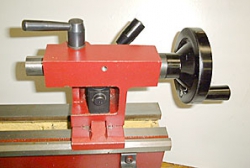There, I am much happier with this. I offset the bearings to get them under the router.This does two things. One is that it puts the center of gravity more balanced over the bearings. The other is that it makes the bed much shorter. This model is just under 5 feet (57 inches) which takes a foot off the previous draft. In effect, it is the cutting length of 48 inches plus the width of the bearings plus a little extra to give some room to mount limit switches. I gave it 1/2 an inch in this draft but that is a pretty tight fit. I will go ahead and make a full 5' for the final version which is the length of the angle I ordered and also the length of the baltic birch I will use to make the rails for the bearings. This will give a bit more room for the limit switches and clamping for the workpiece to the table. Also, the beam of the gantry is a separate piece. I will bolt the three sections of the gantry together so it can be disassembled. This will allow for adjustment to square the gantry to the cutting surface and to shim it to make it level as well.
With the X-Axis all the way to the right, the cutting axis is past the 2' x 4' sheet With the X-Axis all the way to the left, the bearings are still supported by the rails. I could go with a more square shape instead of the curve but the curve will be nicer. It is not too hard to make that kind of curve. I will be making a lot of the gantry out of 1/8" plywood (4mm or so in reality). They sell it as door skin and I have a couple sheets of it left over from my last boat building project. It is luan plywood. This thin stuff doesn't have many defects and bends quite nicely.

In keeping with my goal of making the gantry light, I will be making the internal blocking out of ply and red cedar. It is easy to work with, cuts well and is nice and light. I might go with a light glass over the wood in places just to tie it together a bit better and make it less susceptible to humidity. Depends on how I feel when I start putting it all together. I still have to think a bit more about how to fit in the drive mechanism.
One other thing I have to do is to make a chip guard for the bearings. I need to maybe move the bearings down a bit and cover the rails to keep dust off of them. This might mean making the rails a bit smaller. Not a big problem. As they are right now, they are very much over designed for the load that they will carry. Since they will be fully attached along the length of the bed, they will be quite strong.










